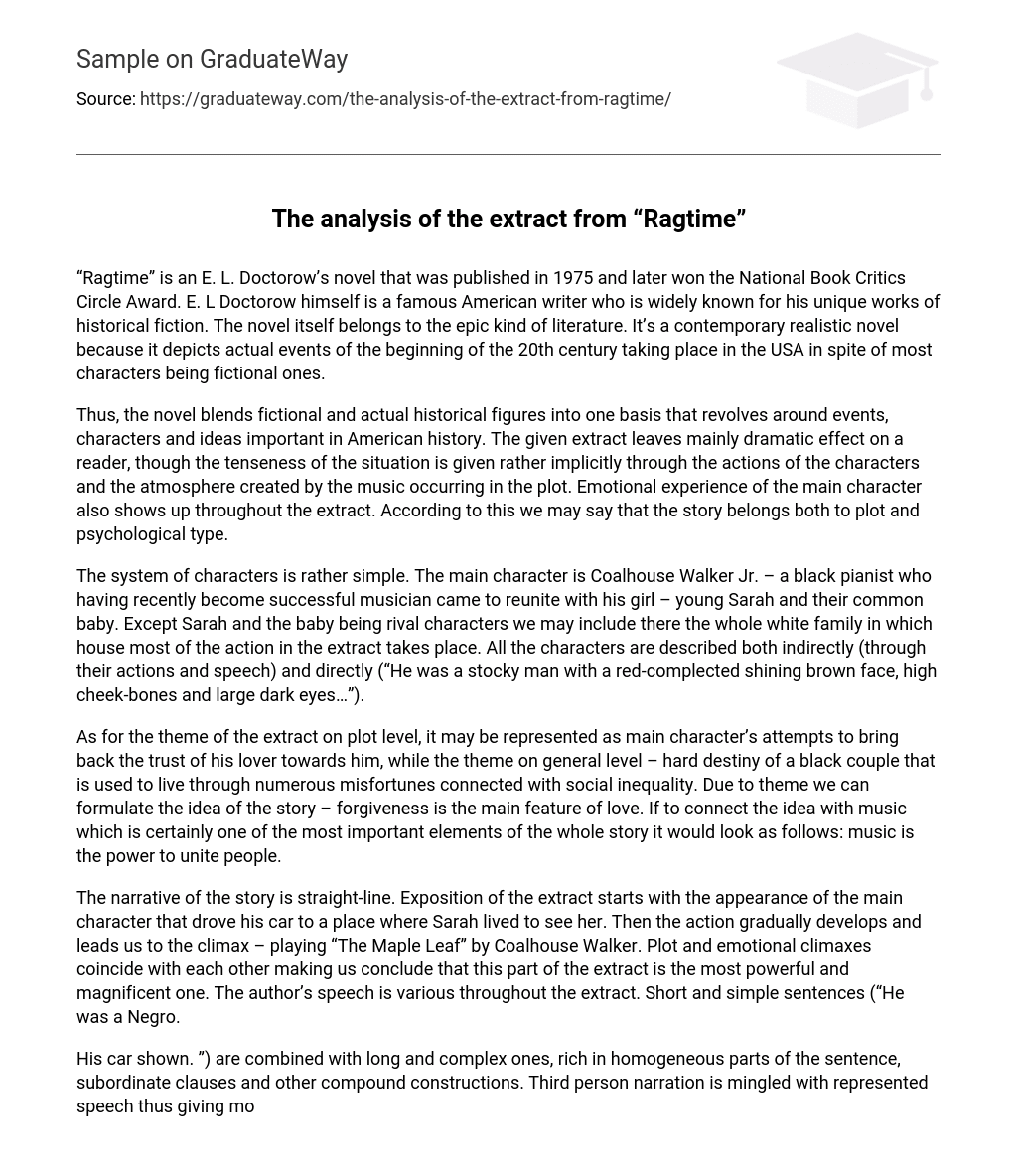“Ragtime” is an E. L. Doctorow’s novel that was published in 1975 and later won the National Book Critics Circle Award. E. L Doctorow himself is a famous American writer who is widely known for his unique works of historical fiction. The novel itself belongs to the epic kind of literature. It’s a contemporary realistic novel because it depicts actual events of the beginning of the 20th century taking place in the USA in spite of most characters being fictional ones.
Thus, the novel blends fictional and actual historical figures into one basis that revolves around events, characters and ideas important in American history. The given extract leaves mainly dramatic effect on a reader, though the tenseness of the situation is given rather implicitly through the actions of the characters and the atmosphere created by the music occurring in the plot. Emotional experience of the main character also shows up throughout the extract. According to this we may say that the story belongs both to plot and psychological type.
The system of characters is rather simple. The main character is Coalhouse Walker Jr. – a black pianist who having recently become successful musician came to reunite with his girl – young Sarah and their common baby. Except Sarah and the baby being rival characters we may include there the whole white family in which house most of the action in the extract takes place. All the characters are described both indirectly (through their actions and speech) and directly (“He was a stocky man with a red-complected shining brown face, high cheek-bones and large dark eyes…”).
As for the theme of the extract on plot level, it may be represented as main character’s attempts to bring back the trust of his lover towards him, while the theme on general level – hard destiny of a black couple that is used to live through numerous misfortunes connected with social inequality. Due to theme we can formulate the idea of the story – forgiveness is the main feature of love. If to connect the idea with music which is certainly one of the most important elements of the whole story it would look as follows: music is the power to unite people.
The narrative of the story is straight-line. Exposition of the extract starts with the appearance of the main character that drove his car to a place where Sarah lived to see her. Then the action gradually develops and leads us to the climax – playing “The Maple Leaf” by Coalhouse Walker. Plot and emotional climaxes coincide with each other making us conclude that this part of the extract is the most powerful and magnificent one. The author’s speech is various throughout the extract. Short and simple sentences (“He was a Negro.
His car shown. ”) are combined with long and complex ones, rich in homogeneous parts of the sentence, subordinate clauses and other compound constructions. Third person narration is mingled with represented speech thus giving more dynamism to the narrative. That is the straight indicator of telegraphic style usage. The brightest example is the violation of punctuation in places having added the direct speech of the characters – all the punctuation marks peculiar to it are omitted (“Sarah, mother said, you have a caller.
The girl said nothing. ”). It is inserted in text as a whole to make the narrative integral, which is certainly the brightest demonstration of author’s style and skill. The title “Ragtime” is supposed to be the symbolic representation of the atmosphere which characterizes the scene of the novel. Apart from that, its symbolism helps us to understand the stylistic peculiarities of the text and the attempt of the author to reflect in the text the features of ragtime music (dynamism of speech and in the same time its integrity).
Also ragtime features reveal in characters themselves, especially in Coalhouse Walker showing on the one hand his restraint and courtesy and on the other hand – fervency and nervousness while telling his life story and playing the piano. The title also accurately reflects the epoch of the events taking place in the novel – epoch in which new opportunities for black people appeared. As for the stylistic devices, the richest part that is full of them is the climax of the story – the scene in which Coalhouse Walker Jr. plays the most famous ragtime of all time – “The Maple Leaf”.
This passage is full of metaphors (“The most famous rag of all rang through the air”, “… music that roused the senses and never stood still a moment. ”), epithets (“thumping octaves” ,”robust composition”, “vigorous music”, “intricate patterns”), similes (“The boy perceived it as light…”), hyperbole (“never stood still”, litotes (“with no effort”), alliteration (“senses stood still”). The most noticeable device is extended metaphor which depicts the visual shape of music played by the main character: “…a light touching various places in space, ccumulating in intricate patterns until the entire room was made to glow with its own being. ” All these stylistic devices brightly show the dynamism of music being played, emotions of the characters that are involved in this scene and represent the whole mood of novel’s narrative. In spite of having at the end of this scene some negative epithets (“mute and unforgiving Sarah”) concerning the inner state of the young woman that are obviously opposed to the mood of the scene in general, we may guess that sooner or later she will inevitably forgive Walker and reunite with him.





